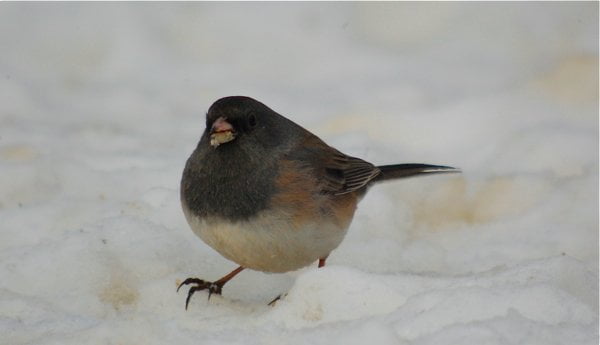Here in Minnesota, we’ve had some freezing weather causing some of our winter birds like Dark-eyed Juncos to come out in full force. Most of them feed on the ground, scrounging for white millet, sunflower chips and Nyjer thistle. When I see birds on the ground, I think about cats.
I recently posted a video on my blog and on my private Facebook account of what I thought was incredible bird footage. Two Hooded Crows are pestering a cat when all of a sudden a second cat jumps in and engages in an all out battle with the other cat. While the epic cat battle plays out, the Hooded Crows continue to pester the cats by yanking on their tails. My suspicion is that the crows had a nest nearby and wanted the cats to leave or at the very least, are mobbing the cats the way they might mob an owl or buteo.
The video is fascinating behavior for all four creatures involved, but the reaction to the video has been the most interesting for me. People who tend to watch the video with a heavy birding perspective see it as interesting behavior. However, cat enthusiasts call the video cruel and are astonished that the videographer did not intervene to stop the cats from fighting. Some speculate the cats are feral and even go so far to as to assume they will spend their short lives limping and soon to die from infected abscesses incurred during the fight. A flame war almost broke out between friends and family on my private Facebook page as people took firm stands on either side of the issue.
There seems to be a disconnect between birders who feel that cats left to roam outdoors contribute a great deal to bird population declines and cat lovers (catters?) who feel that these are loving animals who are misunderstood and in dire need of protection and bird declines are the result of habitat destruction…not cats introduced and contributing to the habitat destruction. Both sides seem frustrated that the other does not understand and a conversation soon leads to angry blanket statements and questions of personal character for not seeing the other sides’ perspective.
To add fuel to that fire, a recent report from the University of Nebraska sheds light on the issue reporting that feral cat colonies are a problem and programs like Trap, Neuter and Release do not work and details methods for capturing and killing feral cats. This is likely not going to make friends in any of the cat rescue community. Here’s an interesting paragraph from the report:
“Some proponents contend that feral cats provide societal benefits by controlling invasive species such as pigeons (Columba livia), house mice (Mus musculus), Norway rats (Rattus norvegicus), and European Starlings (Stumus vulgaris). Feral cats do kill some of these animals, but they are not effective in controlling populations because pigeons, house mice, and Norway rats have adapted to living in close association with humans and human-related disturbance. In California, 67 percent of rodents, 95 percent of birds, and 100 percent of lizards brought home by cats were native species, and native birds were twice as likely to be seen in areas without cats. House mice (an invasive species) were more abundant and native rodents less abundant in areas with cats.”
The full report can be read here but it is eye opening. Will this report help? Perhaps it will open up some conversations for people unaware of this issue, but we are still a long way off from getting bird lovers and cat lovers to agree on a strategy that best for both wild birds and non native cats.














Nice, Sharon. The cat rescue community and TNR proponents can be commended on their compassion, but that compassion should be extended to the countless native species disrupted and destroyed by feral cats.
Here in NYC the mayor’s office actually supports a huge TNR training program and encourages citizens to start their own TNR colonies. But when one asks for information about where the colonies are or how many there are one gets ignored.
In Kingston NY, the Mayor just appointed a 15 member board specifically to come up with a plan to deal with this problem. The local paper the Kingston Freeman ran an editorial on the problem
yesterday.
The newly created board’s mission.
“Our mission is to have a community where no kittens are born wild on the street, where no cat capable of living in a home is lacking one, and where no adult feral cat or abandoned cat goes without food, water, and the appropriate care and concern they deserve.”
The editorial touched on the threat to the bird population.
I will be following the progress with great interest.